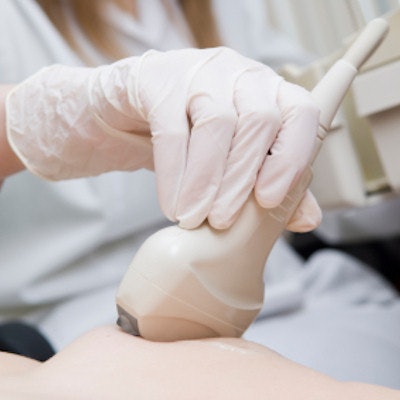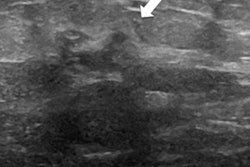
Extended ipsilateral breast ultrasound can detect a significant number of extra cancers compared with the standard screening protocol alone, U.K. researchers of an extensive study have revealed. Less effect was demonstrated for complete contralateral breast ultrasound, they added.
The study included nearly 350,000 patients and determined the number of multiple cancers. The researchers, led by Dr. Victoria Scott, a radiology registrar from St. George's University Hospitals National Health Service (NHS) Trust, sought to determine how many extra cancers were detected due to their local practice of bilateral breast ultrasound.
"Extended ipsilateral ultrasound detects a significant number of extra cancers (14%) compared with the standard U.K. screening protocol (11%) alone," she told attendees at ECR 2018 in Vienna. "Less effect was demonstrated for complete contralateral breast ultrasound in our unit."
Using ipsilateral breast ultrasound
The national breast screening program in England gives clear guidance on breast health and assessment that's based on standard triple assessment and includes further mammographic views where applied and digital breast tomosynthesis (DBT) when available. Targeted ultrasound of suspicious lesions with a needle biopsy is employed where appropriate. The guidelines also mention extending the ultrasound examination to include the whole ipsilateral breast if the breasts are dense, but this isn't mandatory at the moment, Scott said.
Previous data published by researchers from St. George's has shown bilateral whole-breast ultrasound increases the preoperative diagnosis of multiple tumors, so all women with a suspicious solid lesion on ultrasound receive this treatment at their hospital.
"In our unit, we had previously looked at the detection of multiple cancers using bilateral breast ultrasound in 2005, with evidence suggesting it was a worthwhile practice," she told AuntMinnieEurope.com. "We wanted to know whether the introduction of digital mammography and DBT had changed things."
The group used the national screening database to identify all women with cancer who were assessed at St. George's from 2008 to 2016, amounting to 347,542 patients. The researchers identified patients with multiple foci of cancer detected during the same assessment episode. They reviewed the imaging of a subset of all women diagnosed with multiple cancers from 2013 to 2015 to quantify the proportion of additional foci identified as a result of their local ultrasound practice alone.
In the subset analysis, they found 166 women with multiple cancers. Further analysis revealed 36 of these women's further foci of disease were identified as a result of their extended ultrasound practice. They found 139 women had ipsilateral cancers and 27 had contralateral cancers.
| Ipsilateral ultrasound compared with standard protocol in the U.K. | |||
| Standard protocol | Local protocol | Additional pickup | |
| Cancer episodes | 1,217 | 1,217 | |
| Multiple cancers | 134 | 166 | 32 |
| % multiple cancers | 11% | 14% | 3% |
"As the majority of additional foci identified were ipsilateral, we then separated out ipsilateral and contralateral cancers," Scott said.
| Contralateral ultrasound compared with standard protocol in the U.K. | |||
| Standard protocol | Local protocol | Additional pickup | |
| Cancer episodes | 1,217 | 1,217 | |
| Multiple cancers | 162 | 166 | 4 |
| % multiple cancers | 13% | 14% | 1% |
Using the local protocol to scan the whole ipsilateral breast, the researchers identified 3% more cancers than the standard protocol alone, which was statistically significant. Scanning the whole contralateral breast, they identified 1% more cancers than the standard protocol alone, which was not statistically significant.
"As expected, we found there was still a significant pickup rate of additional cancers using ultrasound, particularly in the ipsilateral breast, but this was less dramatic than our previously published data, possibly secondary to the introduction of the newer mammography techniques," Scott noted.
Few studies in the literature comment on ipsilateral whole-breast ultrasound. One small study showed a 10% additional pickup rate of ultrasound over mammogram alone when scanning the whole ipsilateral breast in a mixed screening/symptomatic setting. The findings at St. George's with a purely screening population were smaller but still significant, she added.
"A more recent study in 2017 showed a significant incremental detection rate in the ipsilateral breast for scanning the whole breast," Scott said.
Extended ipsilateral ultrasound detects a significant number of extra cancers, but more work needs to be done on the modality's effect, particularly regarding patient outcome and mortality. Is there an acceptable increase in the rate of benign biopsies? That's precisely what the team is focusing on next.



















